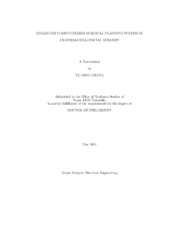| dc.contributor.advisor | Xiong, Zixiang | |
| dc.creator | Chang, Yu-Bing | |
| dc.date.accessioned | 2012-07-16T15:57:18Z | |
| dc.date.accessioned | 2012-07-16T20:32:25Z | |
| dc.date.available | 2012-07-16T15:57:18Z | |
| dc.date.available | 2012-07-16T20:32:25Z | |
| dc.date.created | 2011-05 | |
| dc.date.issued | 2012-07-16 | |
| dc.date.submitted | May 2011 | |
| dc.identifier.uri | https://hdl.handle.net/1969.1/ETD-TAMU-2011-05-9305 | |
| dc.description.abstract | In the field of craniomaxillofacial (CMF) surgery, surgical planning is an important and necessary procedure due to the complex nature of the craniofacial skeleton. Computed tomography (CT) has brought about a revolution in virtual diagnosis, surgical planning and simulation, and evaluation of treatment outcomes. It provides high-quality 3D image and model of skull for Computer-aided surgical planning system (CSPS).
During the planning process, one of the essential steps is to reestablish the dental occlusion. In the first project, a new approach is presented to automatically and efficiently reestablish dental occlusion. It includes two steps. The first step is to initially position the models based on dental curves and a point matching technique. The second step is to reposition the models to the final desired occlusion based on iterative surface-based minimum distance mapping with collision constraints. With linearization of rotation matrix, the alignment is modeled by solving quadratic programming. The simulation was completed on 12 sets of digital dental models. Two sets of dental models were partially edentulous, and another two sets have first premolar extractions for orthodontic treatment. Two validation methods were applied to the articulated models. The results show that using the proposed method, the dental models can be successfully articulated with a small degree of deviations from the occlusion achieved with the gold-standard method.
Low contrast resolution in CBCT image has become its major limitation in building skull model. Intensive hand-segmentation is required to reconstruct the skull model. Thin bone images are particularly affected by this limitation. In the second project, a novel segmentation approach is presented based on wavelet active shape model (WASM) for a particular interest in the outer surface of the anterior wall of maxilla. 19 CBCT datasets are used to conduct two experiments. This model-based segmentation approach is validated and compared with three different segmentation approaches. The results show that the performance of this model-based segmentation approach is better than those of the other approaches. It can achieve 0.25 +/- 0.2mm of surface error distance from the ground truth of the bone surface.
Field of view (FOV) can be reduced in order to reduce unnecessary radiation dose in CBCT. This ROI imaging is common in most of the dentomaxillofacial imaging and orthodontic practices. However, a truncation effect is created due to the truncation of projection images and becomes one of the limitation in CBCT. In the third project, a method for small region of interest (ROI) imaging and reconstruction of the image of ROI in CBCT and two experiments for measurement of dosage are presented. The first experiment shows at least 60% and 70% of radiation dose can be reduced. It also demonstrates that the image quality was still acceptable with little variation of gray by using the traditional truncation correction approach for ROI imaging. The second experiment demonstrates that the images reconstructed by CBCT reconstruction algorithms without truncation correction can be degraded to unacceptable image quality. | en |
| dc.format.mimetype | application/pdf | |
| dc.language.iso | en_US | |
| dc.subject | Centric occlusion | en |
| dc.subject | craniomaxillofacial surgeries | en |
| dc.subject | dental alignment | en |
| dc.subject | dental occlusion | en |
| dc.subject | digital dental articulation | en |
| dc.subject | 3D segmentation | en |
| dc.subject | active shape model | en |
| dc.subject | statistical shape model | en |
| dc.subject | cone-beam computed tomography | en |
| dc.subject | truncation effect | en |
| dc.subject | region of interest imaging | en |
| dc.subject | truncation correction | en |
| dc.title | Enhanced Computerized Surgical Planning System in Craniomaxillofacial Surgery | en |
| dc.type | Thesis | en |
| thesis.degree.department | Electrical and Computer Engineering | en |
| thesis.degree.discipline | Electrical Engineering | en |
| thesis.degree.grantor | Texas A&M University | en |
| thesis.degree.name | Doctor of Philosophy | en |
| thesis.degree.level | Doctoral | en |
| dc.contributor.committeeMember | Braga-Neto, Ulisses | |
| dc.contributor.committeeMember | Ji, Jim | |
| dc.contributor.committeeMember | Boas, Harold P. | |
| dc.type.genre | thesis | en |
| dc.type.material | text | en |


